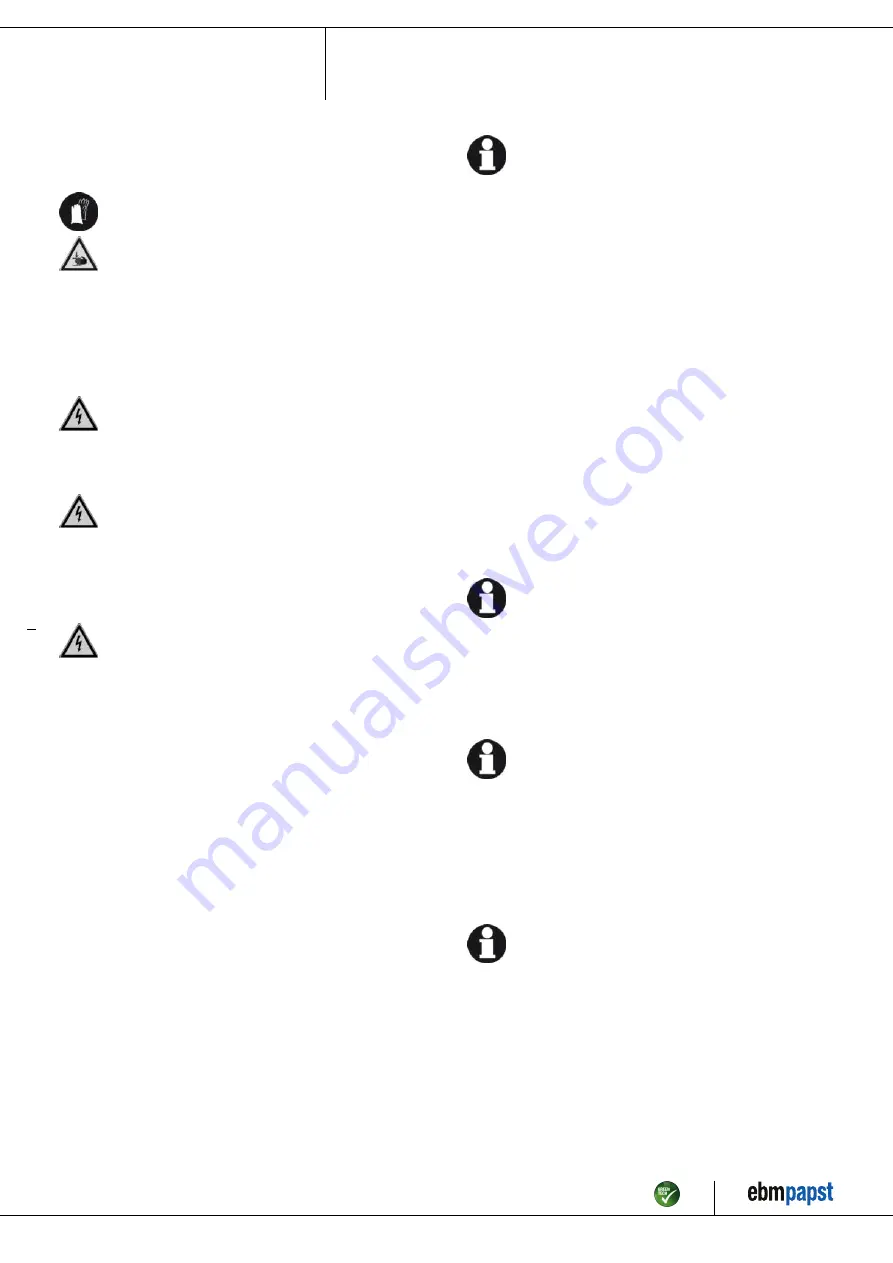
Operating instructions
S3G250-BC54-01
Translation of the original operating instructions
4. CONNECTION AND START-UP
4.1 Connecting the mechanical system
CAUTION
Cutting and crushing hazard when removing the fan
from the packaging
→ Carefully remove the device from its packaging, only
touching the guard grille. Make sure to avoid any shock.
→ Wear safety shoes and cut-resistant safety gloves.
;
Check the device for transport damage. Damaged devices must no
longer be installed.
;
Install the undamaged device according to your application.
4.2 Connecting the electrical system
DANGER
Electric voltage on the device
Electric shock
→ Always install a protective earth first.
→ Check the protective earth.
DANGER
Incorrect insulation
Risk of fatal injury from electric shock
→ Use only cables that meet the specified installation
requirements for voltage, current, insulation material, load etc.
→ Route cables such that they cannot be touched by any
rotating parts.
DANGER
Electrical load (>50 µC) between mains wire and
protective earth connection after switching of the supply
when switching multiple devices in parallel.
Electric shock, risk of injury
→ Make sure that sufficient protection against accidental contact
is provided.
Before working on the electrical connection, the
connections to the mains supply and PE must be shorted.
CAUTION
Electrical voltage
The fan is a built-in component and features no electrically
isolating switch.
→ Only connect the fan to circuits that can be switched off with
an all-pole separating switch.
→ When working on the fan, you must switch off the
installation/machine in which the fan is installed and secure it
from being switched on again.
NOTE
Water penetration into leads or wires
Water enters at the cable end on the customers side and can
damage the device.
→ Make sure that the cable end is connected in a dry
environment.
Connect the device only to circuits that can be switched off
using an all-pole disconnecting switch.
4.2.1 Prerequisites
;
Check whether the data on the type plate agree with the connection
data.
;
Before connecting the device, ensure that the supply voltage matches
the operating voltage of the device.
;
Only use cables designed for current according to the type plate.
For determining the cross-section, follow the basic principles in
accordance with EN 61800-5-1. The protective earth must have a
cross-section equal to or greater than the outer conductor cross-
section.
We recommend the use of 105°C cables. Ensure that the minimum
cable cross-section is at least
AWG26/0.13 mm².
Earth wire contact resistance in accordance with EN 60335
Compliance with the impedance specifications in accordance with EN
60335 for the protective earth circuit must be verified in the end
application.
Depending on the installation situation, it may be necessary to install an
additional protective earthing conductor via the additional protective earth
connection point available on the device.
4.2.2 Idle current
Because of the EMC filter integrated for compliance with EMC
limits (interference emission and interference immunity), idle
currents in the mains cable can be measured even when the
motor is at a standstill and the mains voltage is switched on.
●
The values lie in a range of typical < 50 mA.
●
The effective power in this operating state (readiness for operation) is
simultaneously at typical < 2 W.
4.2.3 Residual current operated device
Only pulse-current sensitive and/or universal RCD protective
devices (Type A or B) are permitted. Like frequency inverters,
RCD protective devices cannot provide personal safety while
operating the device. When switching on the power supply of
the device, pulsed charge currents from the capacitors in the
integrated EMC filter can lead to the RCD protective devices
triggering without delay. We recommend residual current
devices with a trigger threshold of 300 mA and delayed
triggering (super-resistant, characteristic K).
4.2.4 Locked-rotor protection
Due to the locked-rotor protection, the start-up current (LRA) is
equal to or less than the nominal current (FLA).
4.3 Connection of the cables
External leads are brought out of device.
;
First connect the "PE" (protective earth) connection.
●
Connect the lines according to your application. When doing so,
observe chapter 4.4 Connection screen.
Item no. 50334-5-9970 · Revision 82795 · Release 2014-05-08 · Page 6 / 10
ebm-papst Mulfingen GmbH & Co. KG · Bachmühle 2 · D-74673 Mulfingen · Phone +49 (0) 7938 81-0 · Fax +49 (0) 7938 81-110 · info1@de.ebmpapst.com · www.ebmpapst.com




























